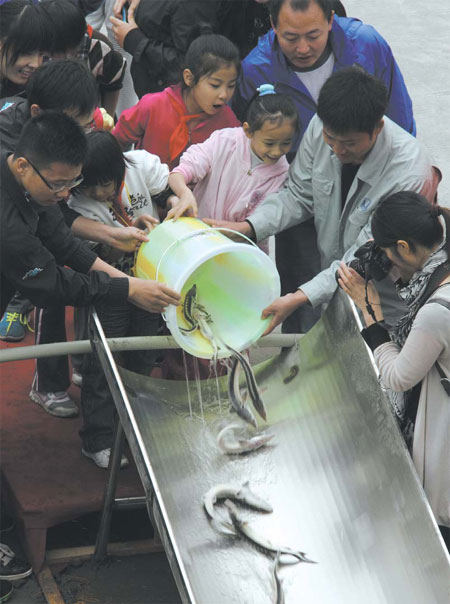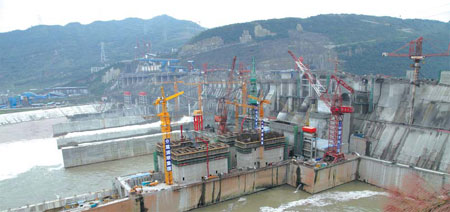Who guards the green guards?
Updated: 2013-02-21 07:25
By Wu Wenchong and Jiang Xueqing (China Daily)
|
||||||||
|
Children from a primary school in Longling county, Yunnan province, introduce endangered fish into the Jinsha River near the Xiangjiaba hydropower project, which borders Longling in Yunnan and Yibin in Sichuan province. Zeng Lang / for China Daily |
|
The Xiangjiaba hydropower facility is one of China's key infrastructure projects. Zhang Guangyu / for China Daily |
The system tasked with safeguarding and assessing the possible environmental damage caused by infrastructure and construction projects is outmoded and badly in need of reform, as Wu Wenchong and Jiang Xueqing report from Beijing.
'Smog" and "haze" have become buzzwords this winter after severe air pollution choked China for several weeks. Equally severe are the country's polluted surface water, ground water and farmland soil. In the face of the worsening levels of pollution, experts have blamed the problem on the disorderly discharge of all kinds of fumes and waterborne waste. They come from factory processes and emissions as well as auto exhausts, during China's 20-plus years of rapid industrial development.
The laws and regulations, which date to the 1970s, were designed to tackle much lower levels of environmental pollution, and now insiders say that only the Environmental Impact Assessment system - tasked with assessing the potential environmental risk posed by any given project before construction begins - has the ability to be the first line of defense against pollution.
However, many experts believe that the system, instigated with the intention of preventing pollution before it can occur, no longer serves the purpose for which it was established, because the pass rate of projects under assessment is almost 100 percent.
Experts said the key problems are that the EIA agencies are paid by project owners, who only care about getting their projects passed, and that the evaluations only begin after the type and scale of a project have been formulated by other government departments.
They have suggested a number of ways the system can be reformed: Ironing out the legal flaws related to the collection of public opinion; ensuring that the EIA agencies are entirely independent of the departments that supervise their reports; and placing greater emphasis on the assessment of regional development plans, rather than on individual projects.
In January, 88 EIA-qualified agencies were publicly admonished by the Ministry of Environmental Protection. They accounted for 18 percent of the 500 agencies whose activities were examined by the ministry between June and October last year.
Two agencies had their EIA qualification canceled and a further eight saw the range of their qualification reduced. The other 78 were ordered to rectify and improve their performances within a specified period.
The investigation uncovered a number of problems, including the poor overall quality of both agency personnel and the assessment documents they produced. More worryingly, some agencies were discovered to have included inaccurate data in their assessments.
The ministry's move was seen as a signal of the government's determination to purge the chaos within the EIA system. Nationwide, there are approximately 1,170 agencies; 190 of them are classified as Grade A, while the others are Grade B.
An agency's grade is determined by the number of EIA engineers it employs: Grade A agencies write assessment reports on projects that can only be approved by the ministry itself, and Grade B agencies write reports about much smaller projects, those approved by environmental departments at provincial level, said Wang Shoubing, an EIA engineer at Fudan University in Shanghai.
'Forged data'
The Chinese Academy of Meteorological Sciences was one of the eight agencies the ministry downgraded from Grade A to Grade B. Its demotion attracted high-profile media attention in January after a group of environmental NGOs sent an open letter to the ministry and the media.
The letter claimed that the academy had used forged data during the EIA process for a waste-incineration power generation project in Qinhuangdao, Hebei province, and requested that its EIA qualification be revoked.
The report, completed in March 2009, claimed that 100 copies of a questionnaire had been handed out to villagers living close to the project, and that 99 of the respondents supported construction of the facility.
However, many villagers balked at the report. Pan Zhizhong, a resident of Panguanying village, one of the four covered by the process, said that in the wake of the consultation process, the villagers discovered that of the 99 people who supposedly supported the project, 15 did not exist, one had died before the questionnaire was issued, 14 had moved away many years before, and one hadn't been seen for eight years after he disappeared while facing criminal charges. A further 65 claimed they had never been given the questionnaire and therefore couldn't have signed it, nor did they support the project.
Although the academy had been downgraded by the ministry, the demotion was unrelated to the Qinhuangdao project. According to information provided by the ministry, the academy was downgraded simply because the number of EIA engineers it employed was below the threshold for a Grade A agency, not because of any suggestion of misconduct.
In its Feb 10 reply to the NGOs, the ministry said "there is no good reason" to cancel the agency's EIA qualification because the distribution and collection of the questionnaire was implemented by the local town government, as requested by the project owner, and that the academy was only responsible for the design of the questionnaire and the compilation of the final report, not the results of the questionnaire.
"The letter seemed to acknowledge that the local government and project owner should be responsible for the collection of public opinion via the questionnaire. But the law doesn't highlight any legal responsibility when the raw data provided by the project owner, including the canvassing of public opinion, were found to be fake," said one of the authors of the open letter, Mao Da, a PhD student at Beijing Normal University, who is an expert in solid-waste management.
The collection of public opinion is one of the weakest aspects of the assessment process, and also the most controversial. The EIA system was proposed in 1979, but not formally legalized until 2002. Public participation in the process was not enshrined in law until 2006.
Wang Qi, head of the Institute of Environmental Engineering Technology at the Chinese Research Academy of Environmental Sciences, said the requirement for public participation in the current Environmental Impact Assessment Law is too simple and imprecise.
He said that despite the claims that the data had been skewed in this case, the general situation has improved over the years. "Nowadays, the level of public support suggested by the final report is usually more than 60 percent. But years ago, the figure was always as high as 90 percent," said Wang. "It must not be too low, though, otherwise it's not possible to move on with the other assessment procedures."
The ministry's reply to the open letter emphasized that a revision of the requirement of public participation is being considered.
All lights are green
"Most of the projects under assessment will be passed eventually, it's always just a matter of time," said Zhao Zhangyuan, a former member of an expert team at the ministry's environmental and engineering appraisal center.
He said the fundamental problem is that the EIA agencies do not provide a public service, but are paid by the project owners. "For them, the EIA is nothing but a necessary step in getting their projects approved and they only care about getting a positive assessment. It's like a lawyer defending a client - you take the job, you get the money, but you certainly don't try to prove your client is guilty."
Moves to salvage the deeply flawed system have been under way since 2010. Wang said all levels of the environmental department are responsible for the evaluation of the assessment reports, but as most EIA agencies are affiliated to the department, a large question mark hangs over the impartiality of the system.
While the goal of the reform is to separate the EIA agencies from the environmental department, experts said the situation has barely changed in the three years since the changes were proposed.
Xia Jun, who has been a public interest lawyer in Beijing for 13 years, argued that the EIA agencies should apply a "credit system".
"A company's previous performance in environmental protection is not taken into account under the current EIA system," he said. "If companies have violated the environmental laws in the past, the requirements to get their projects passed by the EIA should be tougher than usual. If that were the case, companies would be more careful about environmental issues, because their past actions may affect their future."
Key projects
More than 50 key hydropower projects are listed in the country's Five-Year Plan for energy development (2011-2015), released by the State Council, China's cabinet, on Jan 23.
One of those is the controversial Xiaonanhai hydropower project in Chongqing, southwest China, which may have a serious impact on the future of rare fish - including the Paddlefish from the Polyodontidae family, the Largemouth Bronze Gudgeon (Coreius guichenoti), and the Chinese suckerfish (Myxocyprinus asiaticus) - that use the Yangtze River as a route to their annual spawning grounds.
In 2000, a crucial conservation zone on the upper reaches of the Yangtze River was built to ease the ecological impact of the Three Gorges Dam project, but it has twice been reduced in size to provide more space for the dams, practically destroying the original purpose of the zone.
Experts perceived the release of the energy plan as a green light for the hydropower projects, although the results of the EIAs have yet to be made public.
The situation corresponds to a problem pinpointed by Chai Fahe, deputy head of the Chinese Research Academy of Environmental Sciences. In a paper published in 2000, Chai commented that China's EIA system is always "in a passive position".
"The assessment always takes place after a development plan has somehow gained government approval, which means the EIA system can only work to come up with catch-up plans to control the potential environmental risks," wrote Chai.
Although the EIA system now covers assessment of the planning of development projects, the situation is still basically unchanged, according to Xia.
"In China, lawsuits about environmental issues all focus on individual projects. A regional plan has never been subject to a lawsuit, something that is normal in the West," he said. "Planning that takes environmental issues into account should be the first line of defense, rather than environmental impact assessment."
Contact the writers at wuwencong@chinadaily.com.cn and jiangxueqing@chinadaily.com.cn
(China Daily 02/21/2013 page6)

 In Photos: 7.0-magnitude quake hits Sichuan
In Photos: 7.0-magnitude quake hits Sichuan
 Li Na on Time cover, makes influential 100 list
Li Na on Time cover, makes influential 100 list
 FBI releases photos of 2 Boston bombings suspects
FBI releases photos of 2 Boston bombings suspects
 World's wackiest hairstyles
World's wackiest hairstyles
 Sandstorms strike Northwest China
Sandstorms strike Northwest China
 Never-seen photos of Madonna on display
Never-seen photos of Madonna on display
 H7N9 outbreak linked to waterfowl migration
H7N9 outbreak linked to waterfowl migration
 Dozens feared dead in Texas plant blast
Dozens feared dead in Texas plant blast
Most Viewed
Editor's Picks

|

|

|

|

|

|
Today's Top News
Live report: 7.0-magnitude quake hits Sichuan, heavy casualties feared
Boston suspect cornered on boat
Cross-talk artist helps to spread the word
'Green' awareness levels drop in Beijing
Palace Museum spruces up
First couple on Time's list of most influential
H7N9 flu transmission studied
Trading channels 'need to broaden'
US Weekly

|

|









